August 15, 2014
Air Date: August 15, 2014
FULL SHOW
SEGMENTS

Flea Collar Ban To Protect Toddlers
View the page for this story
The EPA has banned certain flea and tick collars for cats and dogs because young children touching their pets can get exposures to unhealthful amounts of pesticides. The move came in response to lawsuits filed by the Natural Resources Defense Council. NRDC Senior Scientist Miriam Rotkin-Ellman tells host Steve Curwood there are safer alternatives. (05:50)

Pesticides on Produce
/ Bobby BascombView the page for this story
An apple a day may keep the doctor away but it comes spiked with a cocktail of chemical pesticides. The Environmental Working Group has released its annual dirty dozen list of the fruits and vegetables with the most detectable pesticide residues. Living on Earth’s Bobby Bascomb reports. (05:40)
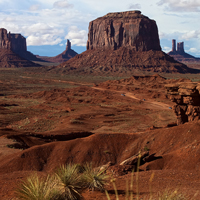
Using Bacteria to Heal the Desert Erosion
View the page for this story
Erosion is a huge problem in the dry American West. But there's hope; soil scientist Matthew Bowker of Northern Arizona University tells host Steve Curwood he's using bacteria to help bring a living crust back to the surface of the desert. (06:30)

Water 4.0
View the page for this story
Increasing population density and changing weather patterns stress our cities’ water supplies, but developing technologies offer positive changes and investments to conserve this most vital resource in coming years. UC Berkeley professor David Sedlak, author of Water 4.0: The Past, Present, and Future of the World’s Most Valuable Resource discusses future water infrastructure with host Steve Curwood. (06:40)
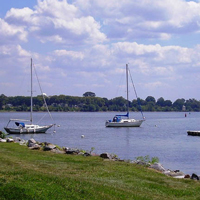
Rain Tax
/ Julie GrantView the page for this story
The EPA wants to limit the storm water run-off going into rivers and streams to help clean up the Chesapeake Bay. Some towns are charging citizens a fee to upgrade storm drains. As Julie Grant of the Allegheny Front reports locals call it a "rain tax." (06:15)

Peak Bagging
/ Emmett FitzGeraldView the page for this story
The Highpointers Club is a group of dedicated and somewhat eccentric outdoor enthusiasts who try to reach the highest point in all 50 states. To achieve their goal, members need to summit giant peaks like Mt. Denali in Alaska. But as Living on Earth's Emmett FitzGerald learned in Rhode Island, even the lowest highpoints can be a challenge. (10:30)

UN Climate Change Reports As Haiku
View the page for this story
The reports of the UN's Panel on Climate Change are critically important but notoriously dense reading. IPCC scientist Gregory Johnson tells host Steve Curwood about his personal project to write haiku poems to make the reports more understandable. (06:00)
Show Credits and Funders
Show Transcript
HOST: Steve Curwood
GUESTS: Matthew Bowker, Miriam Rotkin-Ellman, David Sedlak, Gregory Johnson
REPORTERS: Bobby Bascomb, Julie Grant, Emmett Fitzgerald
[THEME]
CURWOOD: From PRI, this is an encore edition Living on Earth.
[THEME]
CURWOOD: I’m Steve Curwood. The dog days of summer bring a plague for people and pets -- biting and stinging insects. Flea collars can bring relief to our animal companions --but they might create an extra problem for us.
ROTKIN-ELTMAN: Flea collars are designed to work by spreading that pesticide on the pet, and when kids come in contact with their pet which they do on a daily basis they come into contact with that very toxic pesticide.
CURWOOD: Also there's an authoritative list of the most pesticide laden fruits and vegetables - but shoppers have their own ideas.
WOMAN 1: I think berries would be at the top of the list.
MAN 1: I would expect the softer greens. I would expect perhaps spinach.
WOMAN 2: I would guess like bell peppers.
MAN 2: I'd guess like maybe root vegetables potatoes, sweet potatoes, yams. Stuff like that?
CURWOOD: We have the answer and more this week on Living on Earth. Stick Around
ANNOUNCER: Support for Living on Earth comes from United Technologies – innovating to make the world a better, more sustainable place to live.
[NEWSBREAK MUSIC: Boards Of Canada “Zoetrope” from “In A Beautiful Place Out In The Country” (Warp Records 2000)]
Flea Collar Ban To Protect Toddlers

The NRDC logo (Photo: Courtesy of the NRDC)
CURWOOD: From the Jennifer and Ted Stanley Studios in Boston and PRI, this is an encore edition of Living on Earth. Summertime can bring a bumper crop of fleas and ticks for our cats and dogs. Many people use pesticide-containing flea collars on their pets, but the EPA is now banning some of those collars because young children who snuggle up to their pets can get exposed to unhealthful amounts of toxins. The ban comes after eight years of litigation brought by the Natural Resources Defense Council to force the EPA to act. We called up Miriam Rotkin-Ellman, a senior scientist at NRDC to tell us about the ban and wiser choices for parents and pet owners. Welcome to the program!
ROTKIN-ELTMAN: Nice to be here.
CURWOOD: Give me the basics here. What’s the problem with flea collars?
ROTKIN-ELLMAN: We’re concerned that there are pesticides that are extremely toxic for kids used in flea collars. And flea collars are designed to work by spreading that pesticide on the pet, and when kids come in contact with their pet which they do on a daily basis, they come into contact with that very toxic pesticide.
CURWOOD: So talk to me about these two chemicals. What are the problems with them as far as science knows?
ROTKIN-ELLMAN: So there are two different pesticides that are part of related classes of pesticides. So tetrachlorvinphos is a kind of pesticide that’s called an organophosphate. And over the last 15 years or so, there’s mounting evidence that organophosphates can interfere with the developing brain so that prenatal exposures and early life exposures to this pesticide can actually result in delays in motor development, loss of IQ points, or neurobehavioral problems such as Attention Deficit Hyperactivity Disorder. So this class, organophosphates, has been linked to all those different problems. The second pesticide, which is propoxur, is part of a related class of chemicals called carbamates, and unfortunately, it also has many of the same toxic characteristics. Both of these are readily available still, unfortunately, on the shelves.
CURWOOD: So what has EPA decided to do about these flea collars?
ROTKIN-ELLMAN: EPA took the right action on porpoxur in March, and issued a cancellation order. Unfortunately, they gave the manufacturers of these flea collars a pretty sweet deal, and allowed for a really long phase-out period. That phase-out period means the companies can keep making these flea collars despite the fact that EPA found them to be unsafe for children, and then also, they can continue to be sold for up to two years to retailers. And then retailers can sell them indefinitely. Now, the other pesticide that we’re worried about, tetrachlorvinphos, the Environmental Protection Agency has been completely silent. We have not received any notification, and that’s why we’re continuing to pursue our court case and hoping that the court can help us get a timeline from EPA and help move it in the right direction as well.
CURWOOD: And what exactly are these products that are going to be taken off the market, although it sounds like it’s going to take two years?
ROTKIN-ELLMAN: So, the brand name for tetrachlorvinphos is called Hartz. They have a number of products, but usually you can see the name Hartz on the label somewhere. And then, propoxur containing products can go by a whole host of names, Biospot, Adams, Zodiac, Sergeants. Those are all examples of products that contain propoxur, but it’s really important to actually take a look at the active ingredient and look for the word propoxur as well because they do change the names quite a bit.

Pesticides in flea collars are harmful to pets and people alike. (Photo: Bigstockphoto)
CURWOOD: Miriam, I have to ask you, if these chemicals are bad for children, what about the pets?
ROTKIN-ELLMAN: Well, pets are mammals too, and unfortunately these two pesticides tetrachlorvinphos and propoxur really interfere with the nervous system of mammals too. There are some good rules of thumb for preventing harm to both pets and kids when you’re talking about using pesticides.
CURWOOD: What are those good rules?
ROTKIN-ELLMAN: It’s always important to keep your toxic pesticides as your last resort, and look for alternative methods to avoid using these pesticides at all. If you do need to use some kind of pesticide for fleas, there are a whole host of options that are less toxic, and even some that can be taken by the pet as a pill and then therefore don’t leave that toxic residue on their fur, which can harm kids.
CURWOOD: Miriam, do you have a dog?
ROTKIN-ELLMAN: I do have a dog.
CURWOOD: So, what do you with your dog when it comes to protecting your dog from ticks and pets?
ROTKIN-ELLMAN: My dog, even though she hates it, gets regular baths. And she looks at me very sad when it’s time, but she gets those baths every other week with just regular dog shampoo. It doesn’t require any special toxic shampoos or anything like that. We keep her bed clean as well, and we try to keep our house pretty clean. And honestly, that’s all we’ve had to use for fleas. Every once in a while there’s a flea and the regular bathing takes care of it. We do live in an area where ticks are a concern, so I end up needing to use a pesticide every once in a while--the least toxic available that is known to provide good coverage for ticks. And I pay attention to where my dog is spending time. If I’m spending time with a lot of kids, I may forgo the pesticide treatment.
CURWOOD: Miriam Rotkin-Ellman is a Senior Scientist at the Natural Resources Defense Council. Thanks so much for taking this time with me today.
ROTKIN-ELLMAN: My pleasure. Thanks for having me.
Related links:
- EPA explains order to take certain flea collars off the market.
- Check out the NRDC guide to safer flea and tick products here
- Miriam Rotkin-Ellman’s Blog
Pesticides on Produce
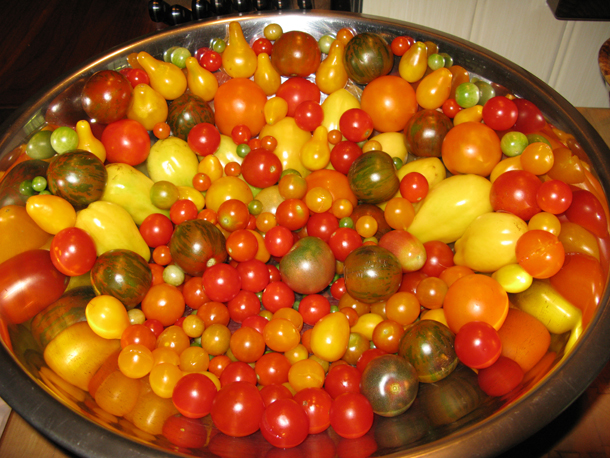
Tomatoes of all colors from Amy Goldman’s garden (Photo: Joanna Rifkin)
CURWOOD: Despite the rapid growth of organic food production, pesticides are widely used on America's farms. And as pests become resistant, more pesticides are applied, which can mean more of these risky chemicals show up in the foods we buy. To help guide consumers, the Environmental Working Group is out with its latest version of its annual list of fruits and vegetables with the least and most pesticide residues. Living on Earth’s Bobby Bascomb has more.
[GROCERY CARTS, BEEP BEEP OF REGISTERS]
BASCOMB: It’s 6 o’clock on a Tuesday: grocery store rush hour at my neighborhood market in Cambridge, Massachusetts. People pop in after work to get food for dinner. In the produce department - amid bins of broccoli, piles of oranges, and stacks of bananas I asked shoppers to take a guess: which item of produce has the most pesticide residue?
WOMAN: I think berries would be at the top of the list. They have such thin skins and they absorb things like that really easily.
MAN: I would expect the softer greens. I would expect perhaps spinach. The softer the leaf the more little pests want to eat it.
WOMAN2: I would guess one of the more colorful vegetables. I would guess like bell peppers or something like that because I feel like whenever I read stuff—it’s the stuff with the most color is the stuff that’s being artificially messed with.
MAN2: I’d guess maybe root vegetables. Stuff like potatoes, sweet potatoes, yams. Stuff like that.
MAN3: I think I saw something once that said apples are really high as far as pesticides, but that’s the only one I remember.
BASCOMB: He’s right. All of those foods are on the dirty dozen list. However, though an apple a day may keep the doctor away it also comes spiked with a cocktail of 5 different types of chemical pesticides. Apples routinely top the Environmental Working Group’s dirty dozen list but this year the researchers are particularly concerned about a chemical called diphenylamine, or DPA. Roughly 80% of American apples are sprayed with DPA after they’ve been picked to protect the skin of the fruit during shipping. Sonya Lunder is a senior analyst with the Environmental Working Group.
LUNDER: Europe actually took action in 2012 to ban this pesticide treatment because they couldn’t guarantee consumers in Europe that this DPA treatment didn’t breakdown to form cancer-causing impurities or breakdown products when the apples were stored.
BASCOMB: Number two on the dirty dozen list: strawberries.
LUNDER: Strawberries grow on the ground. They’re very susceptible to pests and spoilage. They’re also a high value crop. So there’s a very aggressive regiment of treating strawberries including fumigating the soil to kill all living creatures in the soil before they plant the little strawberry starts.
BASCOMB: And rounding out the top three produce items with the most pesticides, grapes. Leafy greens aren’t off the hook though. Kale and collard greens are frequently contaminated with insecticides known to be toxic to the human nervous system, but potatoes have the most pesticides by weight. Lunder says that doesn’t mean people should stop eating fruits and vegetables, instead she advises them to choose organic when possible.
LUNDER: If you have limited money to buy organic foods, focus on those foods that are on the dirty dozen list, and when your organic dollars are tight consider the clean 15 as a group of foods that have very few pesticide residues on them.
BASCOMB: Avocados have the least pesticides of any food tested, followed by sweet corn, and pineapple. Researchers test the part of the produce people eat and generally fruits and vegetables with a thick non-edible outer skin have less detectible residue.
BASCOMB: Most of the shoppers in my grocery store were surprised when I told them about the high concentration of pesticides on apples, and they had mixed feelings about buying organic instead.
WOMAN: I’ll be thinking about it but I’ll still probably buy the same food to be honest. I’m poor, so organic is expensive!
MAN: We do eat organic. Pesticides and other reasons—it tastes better, it’s better for you.
MAN: I’m definitely concerned about pesticides and try to avoid non-organic produce when I can. I actually get a farm share most of the year.
WOMAN: I’m kind of the type that’s like it’s worrisome but there’s not much I can do about it.
MAN: I don’t know what to make of it. I mean, I wash everything pretty thoroughly anyway so…
BASCOMB: (on tape) This report, actually the way they did it, they washed everything very thoroughly and then they tested it so this is the pesticides that you can’t wash off.
MAN: Well, that’s upsetting….
BASCOMB: The pesticides USDA and FDA researchers found in this study can’t be removed by washing the food. The shoppers I talked to were left wondering if eating pesticides on produce is safe. Sonya Lunder from the Environmental Working Group says there’s no ethical way scientists can test the safety of people consuming pesticides. But several studies have examined the health outcomes of children who live in farming communities and were exposed to pesticides.
LUNDER: These long term studies of American kids found that kids with the higher levels of exposure to these pesticides had lower IQs and they had signs that their brain and nervous system development had been altered or disrupted from the pesticides. And in the IQ studies—it’s like a 6 point IQ drop which is equivalent to lead poisoning.
BASCOMB: Lunder says the children in the farm study were likely exposed to more pesticides than the residue found in the food we eat. However, young children and pregnant women are still most at risk for problems associated with pesticides so she advises people buying for those groups to be extra choosy in the produce department of the grocery store.
For Living on Earth, I’m Bobby Bascomb in Cambridge, Massachusetts.
Related links:
- EWG’s Shopper’s Guide to Pesticides in Produce
- The EWG’s list of “All 48 fruits and vegetables with pesticide residue data”
[MUSIC: Innamorati “Clownie” from Generation Bass Presents: transnational Dubstep (Six Degrees Records 2010)]
CURWOOD: Coming up: How tiny creatures can help solve the big problems of soil loss and dust storms. Keep listening to Living on Earth.
[CUTAWAY MUSIC: Monty Alexander: “Monty’s Groove” from Monty Meets Sly And Robbie (Telarc Jazz 2000)]
Using Bacteria to Heal the Desert Erosion
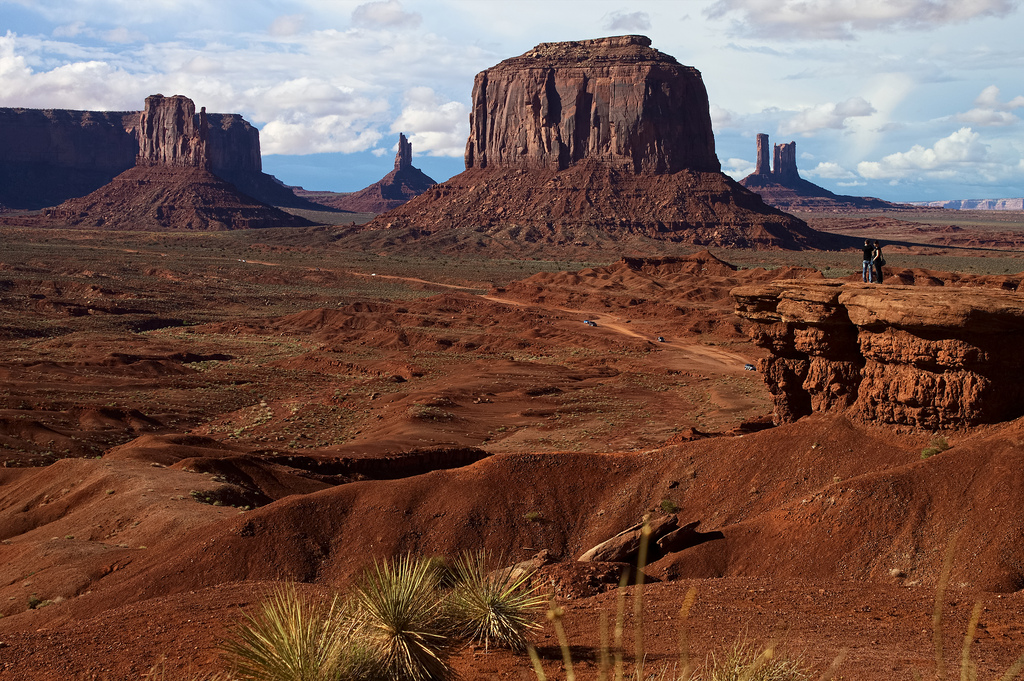
Desert (Photo: Project 1080; Flickr Creative Commons)
CURWOOD: It's Living on Earth. I'm Steve Curwood. Soil is the delicate skin of the Earth that holds everything from complex microbial systems to vast amounts of carbon that would otherwise add to global warming. Human activities have led to a lot of soil loss over the years, so some people are busy working on new approaches to help reverse that trend. One of them is Matthew Bowker, who teaches at the Northern Arizona University School of Forestry and studies how damaged soil crusts might be restored. He sees much of the soil loss out in the desert west as the direct result of recent weather events and land use changes.
BOWKER: For the last 15 years or so, we've seen out in the west, an awful lot more dry years than wet years, also pretty warm temperatures, and that in conjunction with land use impacts that people have out on the landscape, we’re seeing increasing emissions of dust in the air. So the dry west is becoming a dustier place.
CURWOOD: Now how does this loss of soil affect the environment in the long run?
BOWKER: Not only are you losing soil that took a very long time to develop and accumulate, some of the dust from the deserts in the southwest finds its way up to the snowpack in the Rockies and the San Juan Mountains. It’s darker than snow, so it speeds up the timing of snowmelt, in such a way that some of the snow is lost straight back to the atmosphere, and it increases the snow-free period so that plants are up and running earlier and consuming water up into the mountains earlier because of this dust from the desert. And when that happens, there’s less snowmelt runoff going into the rivers, and this affect is sizable. This is decreasing the snowmelt flow to the Colorado River by about five percent.
CURWOOD: So what are you doing to address this? Talk to us about your research.
BOWKER: Well, I am seeking to rebuild the living skin of the Earth. I study a not-very-well-known desert community of organisms called biological soil crusts, and what these are—it’s a sort of an amalgam of cyanobacteria which you may be familiar with as blue-green algae, and also mosses and lichens—and they grow just sort of in a thin veneer on the desert soil surface. They’re common in deserts throughout the world. But the thing with these guys is they are very easily lost due to physical disturbances, things like livestock hooves or vehicle tracks or human footprints, and they don’t come back very fast. So, a lot of my research is focused on finding ways and building a technology to rebuild these soil crusts.
CURWOOD: How do you do that?
BOWKER: Well, some of these organisms you can grow in the laboratory. The idea is that once you learn how to cultivate these guys really well, and cultivate the right ones, you then need another technology to sort of deploy them back out into the environment in such a way that they become established. The technology does not really exist yet to do it on a really big scale, with the exception of some fascinating stuff they’ve done in China where they’ve actually used straw to stabilize sand dunes, and once they create the stability, they have been able to just naturally grow back both plants and these biological soil crusts. It still takes a while. It takes a couple of decades to get a strong biological crust going, but it’s an awful lot faster than recovery on a mobile dune which you know, you could sit around waiting for hundreds of years.
CURWOOD: So let’s fast-forward and say you, in fact, find a way to reproduce and then distribute this stuff on the soil. Where do you think this approach would be most useful here in the U.S.?
BOWKER: All the livestock in the west are creating issues with the trampling due to their hoof action and the impacts they have on these crusts. So I think what you could do is in a place that has been impacted by too much grazing, you could use this technology to sort of heal that area, and I think the other area would be in finding dust emission hot spots. Dust is kind of a hot spot driven thing. There’s a little bit of dust coming from the entire west, but there’s an awful lot of dust coming from a handful of places. So, a technology like this could maybe be strategically deployed in places that we identify that are emitting an awful lot of dust.
CURWOOD: Where are some of those dust hot spots right now?
BOWKER: There’s one south of Phoenix. There’s a big area of some used, some abandoned cropland. Just east of Flagstaff there’s a big area that blows dust straight to the San Juan Mountains. It’s kind of a triple whammy of naturally erodable soils, some land use impacts, and our drought conditions. That’s why it’s blowing a lot lately.
CURWOOD: So that dust hotspot near Phoenix—we see that on television from time to time, when a cloud just makes the city disappear.
BOWKER: Yes, in fact, the Arabic word for “haboob” is a word for dust storms that is now part of the lexicon in Phoenix. People know that word now because they’re getting used to these storms that slowly roll in that are thousands of feet high.
CURWOOD: So overall, what do you think is the potential to use these organisms to heal the soil? To what extent could you solve erosion problems on a large scale?
BOWKER: That’s yet to be seen, but I think the potential is great. You know, if we solve all these technical problems and put in the research and development, we could really have the solution to these issues. You know, before, we’d usually try to attack more problems like this by trying to get more vegetation to grow, and adding a bunch of seed to the environment, but that ends up being a very expensive practice that really does not work well at all. Basically we need something that works better, and will continue to work better as our climate keeps getting warmer and possibly dryer.
CURWOOD: Matthew Bowker is an ecologist at Northern Arizona University. Thank you so much for taking the time today, Matt.
BOWKER: Thank you very much. It was a pleasure.
Related links:
- Check out Mathew Bowker’s article describing his work
- Mathew Bowker’s page at Northern Arizona
[MUSIC: Madrid “Tierra Del Fuego” from Warm Waters (Aporia Records 2003)]
Water 4.0

Potable water (Photo: Bigstockphoto)
CURWOOD: Agriculture, cities, hydro-electricity, tourism, wild-life—there are many competing demands on the scarce water in California. That drought has focused attention on how we should manage our water supply as populations grow and the planet warms. And a timely book called Water 4.0 was recently published by David Sedlak, a UC Berkeley professor of civil engineering and co-director of the Berkeley Water Center.
SEDLAK: I wrote this book because I work in the technical aspects of water supply and water treatment, and I would have lots of conversations with people in cities that were contemplating new kinds of water systems. And I was surprised at how little they understood about this hidden system that delivers their water, treats it to make it safe to drink, and disposes or recycles it after they’re done using it.
CURWOOD: Professor Sedlak writes over the centuries there was water 1.0, when Rome built aqueducts and disposed of waste. Water 2.0 saw 19th century Europeans chlorinate and filter drinking water; followed by our present system, water 3.0, that treats sewage as well. But David Sedlak says now it's time to update to water 4.0.

Water faucet outside of home (Photo: Quinn Dombroski; Creative Commons)
SEDLAK: Well we're all familiar with one of the first tenets of water 4.0: and that’s water conservation. So, quietly over the last 10 or 20 years, we’ve seen indoor plumbing change as people are switching out their top-loading washing machines for front-loading washing machines, and we’ve saved a lot of water that way. We can do better and we will do better. The other part of water 4.0 involves the creation of local sources of water, and the recycling of water. So those local sources of water are things like capturing urban storm water run-off. We can also build seawater desalination plants, and those desalination plants can be a new local supply of water. And finally we can start recycling our water, either recycling it close to the home with something like greywater, or we can recycle the sewage after it’s been treated and put it back into the water supply.
CURWOOD: We use perfectly good drinkable water in our toilets. How should we change that system going ahead with what you call water 4.0?
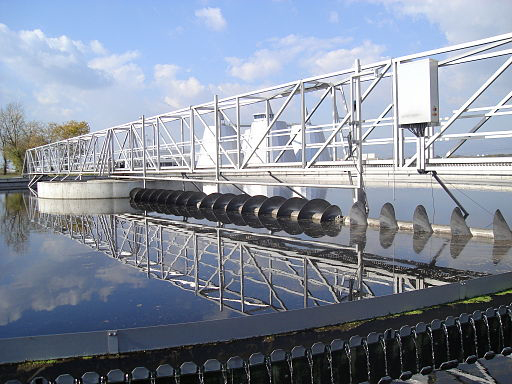
Wastewater treatment plant (Photo: Hasan Zulic; Creative Commons)
SEDLAK: The reason that we put perfectly good water into our toilets is that it’s hard to have two separate types of water coming into the home. So once we built our homes with only one kind of pipe coming into it, and then we got this idea, well, maybe we should put a second kind of water into the house, a recycled water, or a water of lower quality, it became very difficult to re-plumb and rebuild everyone’s houses with a second distribution system. And so, an alternative would be to find a way to get rid of our wastes without using so much water. So the modern flush toilet that many of us have in our homes, uses about 1.5 gallons per flush. It’s possible to reduce that with a vacuum toilet, the kinds of toilets that we’re familiar with on airplanes. So you could reduce the amount of water that the toilet uses to a little less than half a liter if you went to a vacuum toilet. The water savings associated with that isn’t huge, so it may not be a good economic investment. But over time, we may be able to actually get away from putting drinking water into our toilets.
CURWOOD: Now, talk to me a little bit about the present drought that is going on in California. With your understanding of what we would need to do to move forward with water, how can we respond to these drought situations?
SEDLAK: The drought that we’re experiencing in California is the worst drought in many decades, but it’s not the only drought. We’ve had a drought in the Colorado River Basin since about 1999, and we recently experienced a pretty severe drought in Texas. I think the drought that is the most instructive to us is the drought in Australia that occurred about a decade ago, and that long drought was a cause for major change in the way Australia provided drinking water to people. So the first stage of the drought looks a lot like the first stage of the drought that we see in the western United States. People call for water rationing and voluntary cutbacks in water use, and that gets you through a year or two. But we have to think of something more than just rationing and voluntary cutbacks. We have to start planning for this next generation of water.
CURWOOD: You talk about local water supplies as a way to respond to the threat of drought. Explain more for me.

Rural area water pipes (Photo: Dave Ferguson; Creative Commons)
SEDLAK: It’s nearly impossible to build a reservoir in the middle of a city, but many cities have a reservoir underneath them. They have the local groundwater supply. So, for example, Los Angeles has some wonderful urban aquifers that serve as a source of water supply for the city. So those urban aquifers are like reservoirs within a city, and if we can recycle water and put it back into the ground, we create a local water supply that we can draw upon even during times of drought.
CURWOOD: What do you make of the social and cultural attitude towards water supply innovation? How prepared are we?

Airplane toilet flush, a solution? (Photo: Creative Commons)
SEDLAK: If the system remains hidden underground and people just turn on the faucet and don’t think about all the effort that goes into getting the water to them, we can’t have an intelligent discussion about water supply. And the idea of seeing water as going through a series of revolutions should comfort us a little bit. That is, throughout history, we’ve had problems with our water supply. They’ve seemed difficult and intractable. There have been unfamiliar technologies we’ve had to adopt. And ultimately, we figure it out, and we become comfortable with water that’s treated, or having sewage that’s treated, or having water that’s imported. So a lot of the discussions that you hear now and the resistance to new sources of water supply should be expected by people who are unfamiliar with where their water comes from and why they need to think about something more than the existing system.

Prof. David Sedlak (Photo: UC Berkeley)
CURWOOD: So what do you think it will take for ordinary citizens to realize that a change is needed?
SEDLAK: There’s nothing like a good crisis to bring about change—whether it’s a public health crisis and people dying from typhoid fever and cholera, whether it’s rivers catching on fire and the Great Lakes dying—all of these things prepare the public for the investments and the discussions and the decisions that have to be made about going to a new way of supplying and treating water.
CURWOOD: By the way, I hear reports that the current drought in California’s making the outlook for wine production a little dimmer, and maybe that will galvanize people into action, huh?
SEDLAK: Or it might force them to experiment with Argentinean and Australian wines.
CURWOOD: David Sedlak is author of Water 4.0: The Past, Present and Future of the World’s Most Vital Resource. He teaches at UC Berkeley. Thank you so much, Sir.
SEDLAK: Thank you, Steve.
Related links:
- Check out David Sedlak’s book and video presentation
- David Sedlak discusses the California drought for the San Francisco Chronicle
- More about David Sedlak
[MUSIC: Bill Frisell “The Big One” from Big Sur (Sony Music 2013)]
Rain Tax

Chesapeake Bay (Photo: Craig Strachan)
CURWOOD: Part of the new thinking about water handling involves a decision by the federal government to restrict how much storm water runs directly off hard surfaces into waterways. For many cities, it’s proving expensive especially in older communities, where culverts are in need of repair. To fix those systems, local governments are starting to charge residents a storm water utility fee—what some call a "rain tax". Julie Grant of the public radio program the Allegheny Front has our story from Pennsylvania.
GRANT: There’s a big hole in the street in the small downtown of Meadville, 40 miles south of Erie. More than seventy years ago, much of the city was built over the top of streams, which are enclosed in concrete tunnels, called culverts. Assistant City Manager Andy Walker says last summer, when Meadville got hit with a huge rain storm, one of the major tunnels clogged.
WALKER: Essentially, the culvert became nearly completely plugged with sediment and debris: rocks, branches. Some from the storm itself, and frankly from other prior events where we haven’t done proper maintenance.
GRANT: A third of the downtown streets flooded. Cars couldn’t get through. The water gushed over and under the roads with so much force, iron manhole covers were pushed up more than six feet off the ground. Six months later, Meadville is still recovering.
GRANT: Walker stands by the hole on Market Street. He says the city had to dig up the street, to get to the underground tunnel. Then they had to figure out how to remove the branches and rocks that were plugging it up.
WALKER: This is where we had opened it up to literally drag out the debris. And we had a pulley system, and dragging a bucket, so we can get it to this hole, and then scoop it up with a traditional backhoe, and then load it out.
GRANT: The $150,000 dollar price tag may not sound bad, but for a small city like Meadville, it’s a significant portion of the budget. Thankfully, Walker says, they don’t have to spend money from the general fund. Last year, Meadville started charging residents a storm water utility fee to pay for maintenance, and for projects like this. Many call it a “rain tax,” but Walker doesn’t like that term.
WALKER: And, in fact, we try not to call it a “tax increase,” because in fact it is a user fee.
GRANT: Walker says like any other utility—water or sewer—people are billed by how much they use it. In the case of a storm water fee, property owners are charged based on the footage of impervious surfaces, such as parking lots and rooftops on their property. He says rainwater runs off of those surfaces into the public storm water system.
WALKER: Depending on the size of your parcel—that’s your billing unit, that’s your impact, that’s your usage of the system—and you’re billed accordingly then.
GRANT: Last January, the average homeowner started paying a new fee, about $90 dollars per year in Meadville. Cities such as Philadelphia and Mt. Lebanon, south of Pittsburgh, have started charging similar fees.
GRANT: More Pittsburgh area municipalities are expected to start considering a storm water fee this year. We asked a few residents about it at a drug store on the East End. Matt Marquette is lawyer, and a homeowner on the east end.
MARQUETTE: I would support any measure that helps develop the infrastructure and limits any sort of pollution that goes into the river waters, which I think are a great local resource.
GRANT: But others we asked don’t want a storm water fee. In the greeting card aisle, Cheryl Fuller stopped to disparage the idea.
FULLER: We don’t need another bill; we have enough. As homeowners, gas, light, water, sewage, and now a sewer fee? No. No. It’s time to become a renter.
GRANT: The state of Maryland recently passed the country’s first statewide storm water fee. It’s expected to cost the average homeowner around $175 dollars a year.
[FOX NEWS THEME MUSIC ON TV]
WILLIS: Taxing rainwater. I know it sounds crazy, but that’s exactly what the state of Maryland is doing, creating a flood of outrage.
GRANT: That’s Gerry Willis on Fox News. Her guest is a county executive from Maryland, Laura Neuman.
WILLIS: So essentially the amount of rainwater that is out-placed by my structure, my building, my house, I get taxed for that. Is that the way it works?
NEUMAN: That’s the idea. They’re thinking the amount of impervious surface on your property, meaning your roof, your driveway, your home will determine the amount of tax that you pay.
WILLIS: I’m telling you, that’s sounds like a ton of dough.
NEUMAN: It is.
GRANT: Neuman says the storm water fee is expected to raise $14 billion dollars by 2025 in Maryland. It won’t raise near that much in Meadville, PA. But it’s still a lot of money for some businesses and large property owners to pay.
GRANT: Cliff Willis is Director of the physical plant at hilly Allegheny College. Its storm water utility bill was $70,000 dollars last year. He says not everyone understands why they’re being forced to pay for run-off from their parking lots and rooftops.
WILLIS: In any community, particularly a small community, you’ll have folks grumbling about additional fees and having to, “Well, we’re just going to move outside of the city limits then.”
GRANT: Willis says there is significant development in a nearby township outside the Meadville city limits. He says township residents don’t pay for police, fire or storm water services. But as a former municipal engineer, himself, Willis supports the new fee.
WILLIS: I’ve been here about 5 and a half years, and on at least 2 occasions, I’ve seen water running down Main Street deeper than 6 inches. So, yes, there certainly is a need for storm water management.
GRANT: Meadville has already spent some of the money mapping its storm water lines, and when a sinkhole appeared in one homeowner’s backyard because of an old line, the city had the $60,000 it needed to build a new one.
GRANT: Meadville’s Andy Walker says even with money from the fee, they can’t fix all the problems. He says when two inches of rain fell in less than 2 hours last summer, some people wanted the city to clean up water in their homes.
WALKER: They’re sort of demanding action, now that they’re paying the storm water fee, and I had to explain to them that a storm of that size, no matter what we did, we almost can’t throw enough money at the problem to fix and prepare for that size event.
GRANT: Pennsylvania already has a lot of rain and snow, and climate scientists predict larger storms in the coming years. Walker says, even with the new fee, fixing the overloaded storm water system is going to take decades.
CURWOOD: Julie Grant's story is part of, Think Outside the Pipes, supported by the Park Foundation and Penn State Public Media.
Related link:
Read more about the story on Allegheny Front’s page
[MUSIC: Joe Sample “Rainy Day In Monterey” from Carmel (UMG Records 1979)]
CURWOOD: Coming up: Heading for the hills to hit the highpoints. That’s just ahead on Living on Earth; stay tuned.
ANNOUNCER: Funding for Living on Earth comes from United Technologies—a provider to the aerospace and building systems industries worldwide. UTC Building and Industrial Systems provides building technologies and supplies container refrigeration systems that transport and preserve food, and medicine with brands such as Otis, Carrier, Chubb, Edwards and Kidde. This is PRI, Public Radio International.
[CUTAWAY MUSIC: Ernest Ranglin: “El Mescalero” from Bless Up (Avila Street Records 2014)]
Peak Bagging

The little red house by the trailhead used to be occupied by Ed Bouchard and Henry Richardson. (Photo: Emmett FitzGerald)
CURWOOD: It's Living on Earth. I'm Steve Curwood. Collecting things is an age-old hobby. From snow globes to baseball cards to sea shells, just about anything can be a collectible if you put it in a nice glass case. But there are people in America who collect something that is never going to fit in a case, the garage, or an attic—the highest points in the 50 states. Emmett Fitzgerald has the story from Foster, Rhode Island.
FITZGERALD: Ask a group of Rhode Islanders what the highest point in the their state is, and you’ll get a few different responses. I’ve heard everything from the fifteenth floor of the Science Library at Brown University to the very top of the landfill in Johnston. Truth is, it’s just an ordinary hill in the woods.
BURK: Right now we’re at the trailhead if you want to call it that, near the summit of the Rhode Island state highpoint; it’s Jerimoth Hill.
FITZGERALD: Since 1992, Stony Burk has crisscrossed the country in dogged pursuit of an unusual goal—to stand on the highest point of every state in the country. Stony climbs each peak on foot, but getting to the trail requires a lot of driving. Today, he’s standing next to a red jeep he calls Cynthia Rose—the car that’s been with him the whole way.
BURK: She’s been to all 48 state highpoints at least twice. She’s on her third time around, and it’s got almost 395 thousand miles on it. Same motor.

The Jerimoth Hill sign next to Stony Burk’s Red Jeep “Cynthia Rose” (Photo: Emmett FitzGerald)
FITZGERALD: Stony isn’t the only one with this vacation-consuming hobby. There’s a whole club of people delighted to drive a few thousand miles to stand on top of Clingman’s Dome, the highest point in Tennessee, or Mount Magazine, Arkansas’ apex.
WALLEN: I’m Roy Wallen and I’ve been in the Highpointers Club for a long time—15, 20 years probably.
FITZGERALD: The club itself goes back longer then that. Stony Burke says it began 30 years ago, with a guy named Jack Longacre.
LONGACRE: Back in 1987, 1988 he posted an ad in Outside Magazine to see if anybody else was as crazy as he was to go to the 50 state highpoints, and he got some immediate responses. And the club was formed from then.
FITZGERALD: Since then, the Highpointers Club has taken off.
LONGACRE: We have over 2,500 dues-paying members.
FITZGERALD: Only a handful of those have reached all 50 state highpoints. A few of the peaks on the list require serious mountaineering experience and a bit of luck. Stony tried to climb Denali in Alaska twice, only to get blown off the mountain both times. Roy Wallen says you have to prepare for each highpoint differently.
WALLEN: Today ’cause it’s raining, I brought a rain jacket and that’s it. If you’re going to a big peak, you could have full winter gear and crampons and ice ax.
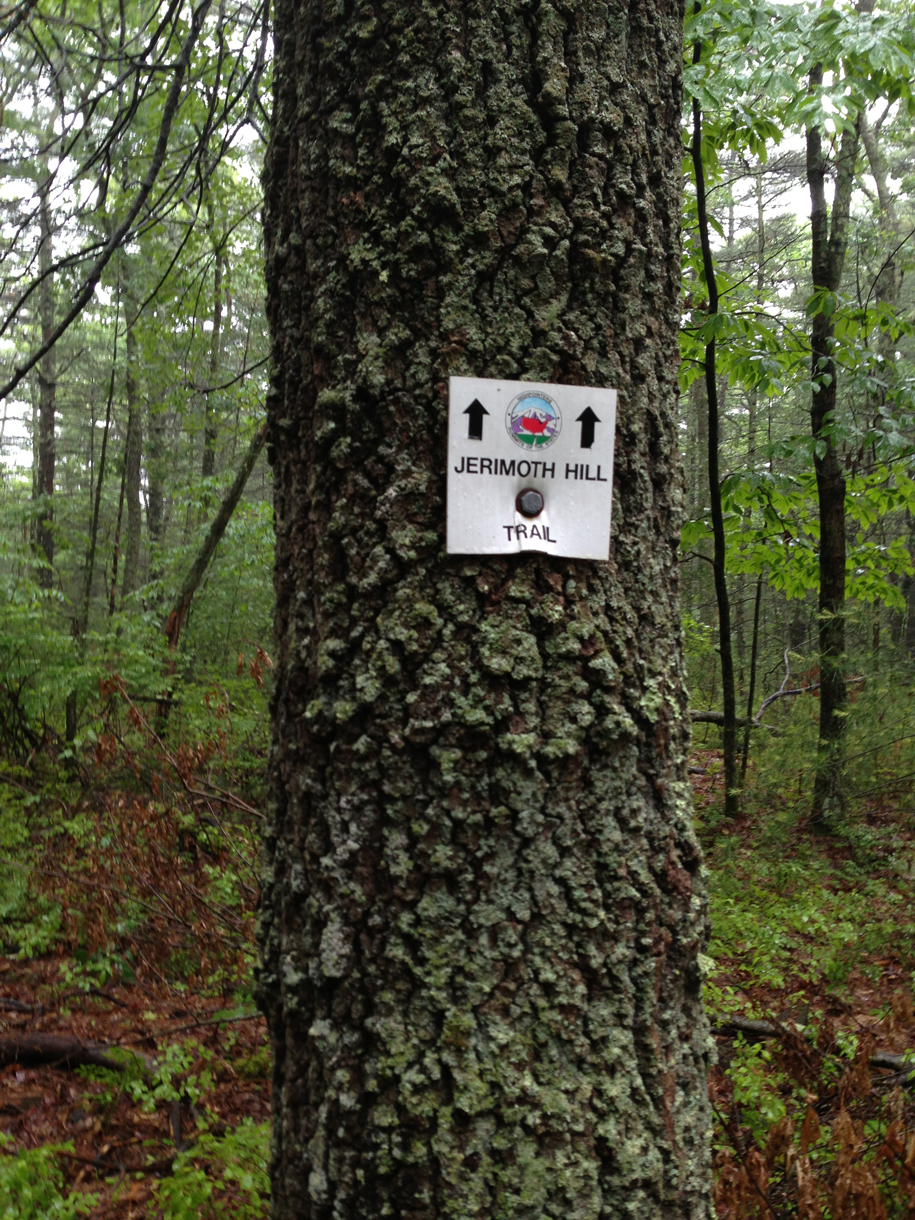
A sign along the trail to Jerimoth Hill (Photo: Emmett FitzGerald)
FITZGERALD: You didn’t bring your crampons for Jerimoth Hill?
WALLEN: [LAUGHS] Not today.
FITZGERALD: Although it’s only 812 feet tall, Jerimoth Hill isn’t the lowest highpoint out there. That title belongs to Florida’s Britton Hill, which clocks in at a mere 345 feet. Still, Stony Burk says the trip to Rhode Island’s highest point isn’t exactly a demanding trek.
BURK: The elevation change from the road to the summit itself is negligible; its probably maybe 8 feet.
FITZGERALD: Although it’s little more than a leisurely walk, Jerimoth Hill wasn’t always so easy to get to. Back in the 1990s, Henry Richardson and Ed Bouchard ran a piano business out of their home by the trailhead. Henry and Ed liked their privacy, and didn’t want hikers wandering around their property looking for the highpoint.
BURK: They would show up in the evening or they would have headlamps on trying to find it. And they’d wander around in the woods because it wasn’t really clear where the actual summit was. And Henry Richardson could hear these people in his woods and he’d get upset about it and chase people out, sometimes with a bed post or maybe even waving a pistol or something like that. I’ve heard several stories, and I’ve had several friends that had those kinds of encounters.
FITZGERALD: Henry Richardson closed access to Rhode Island’s highpoint altogether, but the highpointers kept coming. Once, a hiker from Iowa tried to take a picture of the no trespassing sign outside Henry and Ed’s little red house.
BURK: Henry ran out of the house and asked him what he was doing and the fella tried to explain it to him. And Henry grabbed his camera, ripped it off his neck, and threw the camera to the ground and broke it. So, he kind of ran away in fear at that point. And he called the police to see if they could do anything about it, and they pretty much explained that he lived in Iowa and Henry was here, and he had the right to keep people off his property.
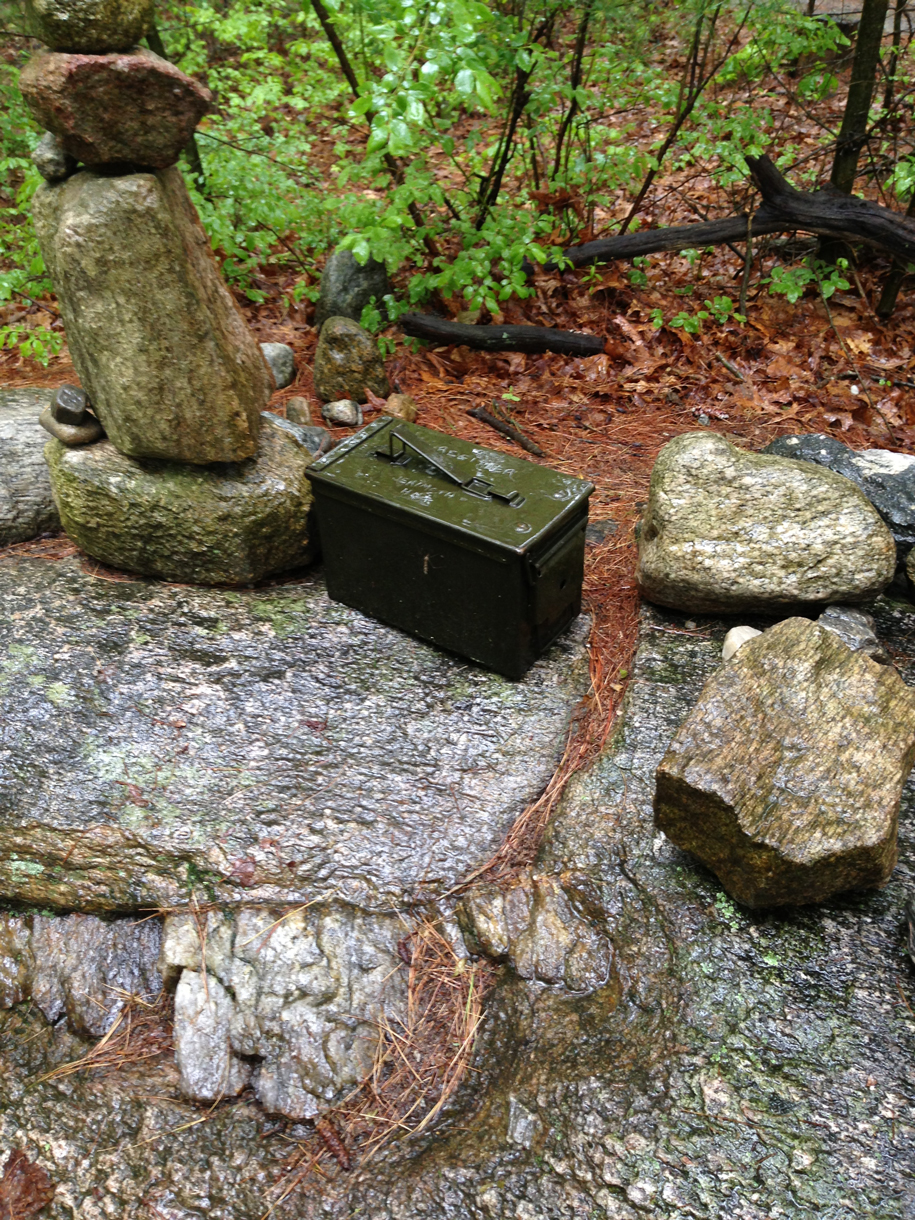
The registry book for Jerimoth Hill is inside an old ammunition box (Photo: Emmett FitzGerald)
FITZGERALD: Then two men from Alaska tried to find an alternate route to the highpoint at night. They crossed through another private property a few doors down from Henry and Ed’s house.
BURK: And the fellas that lived there ended up holding the Alaskans at gunpoint until the police came and arrested them.
FITZGERALD: Little Jerimoth Hill soon became notorious in the highpointing community. Rhode Island’s biggest bump stymied climbers with Rocky Mountain credentials. At the height of the Jerimoth Hill drama, the club website declared it “America’s most inaccessible highpoint.” Some people even suggested the state circumvent the problem by adding 8 feet to Durfee Hill, Rhode Island’s second highest point.
FITZGERALD: But the club continued to negotiate for access, and in 1999 they struck a deal with Henry and Ed to allow hikers access to the summit on a few days each summer. Highpointers from all over the country flocked to Rhode Island for a chance to bag Jerimoth.
BURK: On average we’d have 70 up to 180 people on those particular days show up.
FITZGERALD: The open-access days continued without serious incident until 2001, when Henry Richardson died, and a couple named Jeff and Debbie Mosley bought the little red house by the trailhead.
BURK: We made fast friends with the Mosley’s over the years. They opened access seven days a week.
FITZGERALD: When the Mosley’s moved out, the state bought the land, and now Jerimoth Hill is open to the public all day, every day.
[FALLING RAIN]
FITZGERALD: As the rain picks up, we make final preparations for our ascent. Stony suggests we time the trip, and Roy says he’ll count our steps. We huddle under my umbrella, and strike out down the trail.
FITZGERALD: 3, 2, 1, here we go.
[MUSIC: Django Reinhardt’s “Django’s Tiger”]
BURK: We’re 48 seconds in and there’s another Jerimoth Hill sign. There’s a little bit of a cross trail here, we’ll take a right.
[FOOTSTEPS]
FITZGERALD: Alright, getting close.
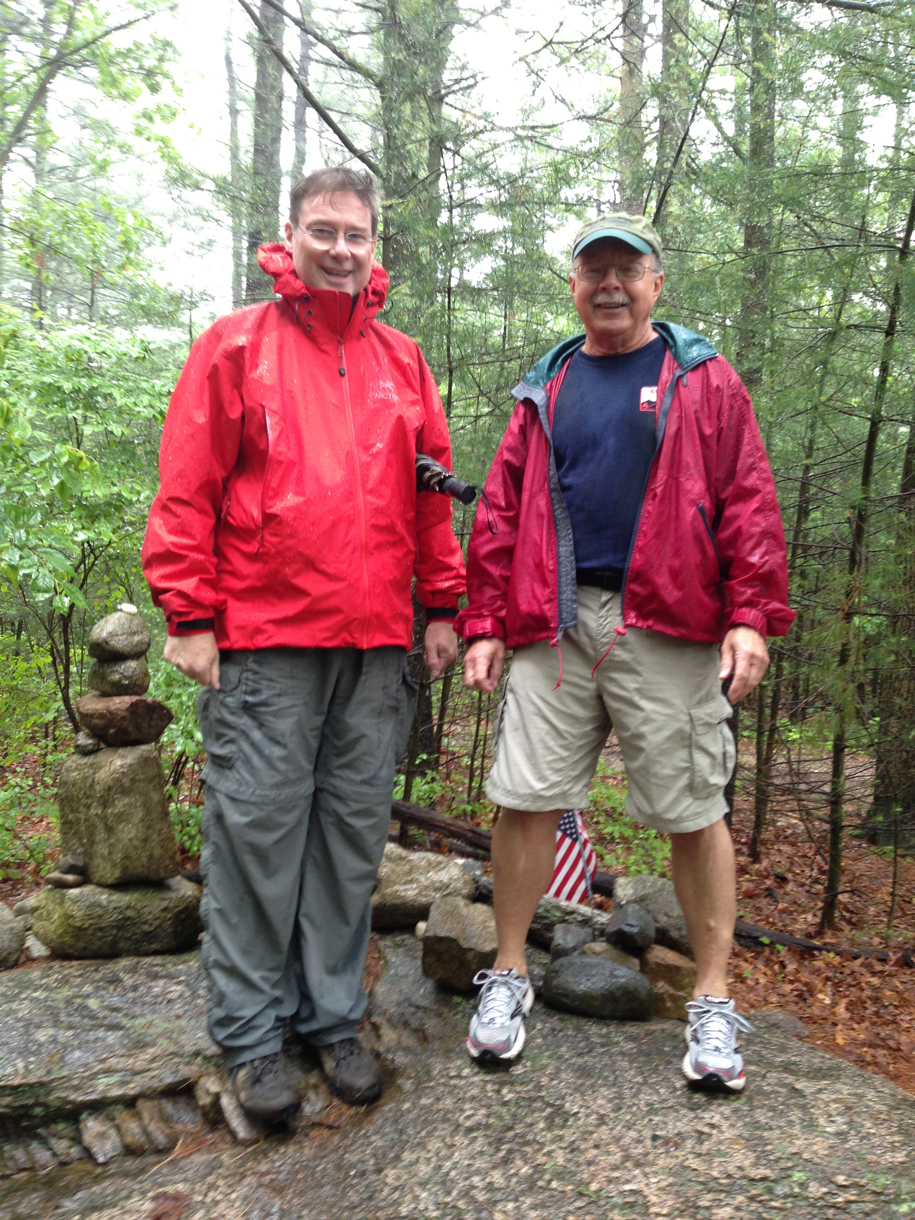
Stony Burk and Roy Wallen taking in the view at the summit (Photo: Emmett FitzGerald)
BURK: Just about 4 minutes in, past another trail sign.
FITZGERALD: Have we arrived?
BURK: We’re here. This is the summit.
FITZGERALD: As we catch our breath, Stony and Roy tally the stats.
BURK: It was right at 300 steps.
FITZGERALD: Three-hundred steps. And our final time?
BURK: Four and a half minutes.
FITZGERALD: Quite a journey.
BURK: It was a rugged haul! I’m glad I prepared for it.
FITZGERALD: How are you guys feeling after that?
BURK: A little out of breath, probably just sit here for a few minutes and recuperate, and hope I can get used to the altitude.
FITZGERALD: Roy says that as highpoints go, Jerimoth Hill isn’t much to look at, just a few rocks in a cluster of trees.
WALLEN: No there’s no view, but it’s a nice spot in the woods.
FITZGERALD: On top of every highpoint there’s a registry book. Jerimoth Hill’s registry is in green ammo box nestled in the rocks.
[BOX OPENING]
FITZGERALD: The damp pages are filled with names of highpointers from all over the country.
BURK: Pennsylvania; West Virginia; the Woodlands, Texas; Gainesville, Florida; Dover, Massachusetts; Binghamton, New York, Silverton, Colorado. Here’s a note: “Can’t believe I put my hiking boots on for this one.”
FITZGERALD: Stony scrawls our names into the logbook, then pulls out a pamphlet about the Highpointers Club. It lists some of the records that the club keeps track of—most highpoints in a single day, most highpoints after age 75, that sort of thing.
BURK: Oldest person to reach a highpoint…
FITZGERALD: Frampton Ellis. How old?
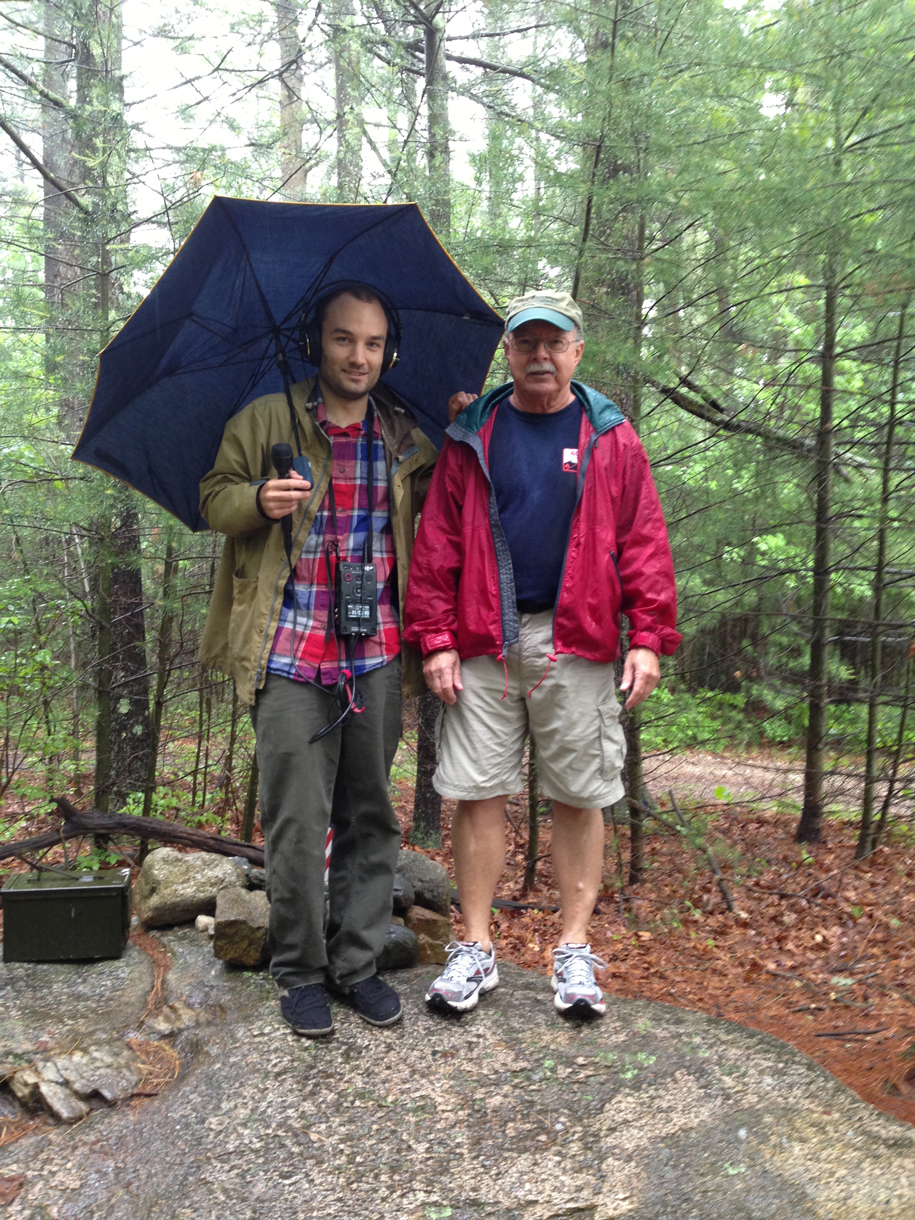
Emmett FitzGerald and Stony Burk at the top of Jerimoth Hill (Photo: Emmett FitzGerald)
WALLEN: Ninety-one years, 17 days. We’ve had the youngest person to reach a highpoint, Natalie Smith is 11 days old, 35 minutes, and that was the state of Pennsylvania. Dave Johnson has done all 50 state highpoints in the winter. That is quite an accomplishment. Dogs on highpoints; that one always kind of cracked me up. The Pelligrini's for example, they’ve taken Ozzie up to 36 state highpoints. That’s a cool thing if you can do that. I think dogs have every right to go to highpoints just like people do.
FITZGERALD: Roy Wallen has a record of his own. Once he climbed the six New England state highpoints, Roy started going to the highest point in every county as well.
WALLEN: I’ve done all the New England county highpoints, so if I’m going to do any new ones I’ve got to venture further west.
FITZGERALD: When you start collecting counties as well as states, highpointing can get a bit out of control.
WALLEN: When we go on vacation, we go so that I can go do a highpoint, either a state or a county high point.
FITZGERALD: What does your wife think?
WALLEN: She thinks I’m crazy. It’s a disease.
FITZGERALD: It may be a little crazy, but Roy says highpointing provides an organizing principle for adventure.
WALLEN: To me the best part is it takes you places in the country where you never would have been otherwise. I probably wouldn’t have gone to Mt. Rushmore if I hadn’t had this driven obsession to go to Harney Peak, which was more important to me.
FITZGERALD: And while not every highpoint would make it into Lonely Planet, each one has something to offer.
WALLEN: They’re all kind of cool; they’re unique. Every one’s got its own special flavor and special attraction.
FITZGERALD: Stony Burke closes up the ammo box and tucks it back among the rocks. Wet, cold, but not the least bit tired, we walk back to the car. Stony’s still got two serious peaks left on his list, Mt. Denali in Alaska and Granite Peak in Montana, and he tells me he’s not stopping any time soon.
BURK: Anytime I can get out on the road, and go to a highpoint, I’m going for it. We’re standing here in the rain today; I have no problem doing that.
FITZGERALD: As we say goodbye, Stony hands me a yellow Highpointers wristband and tells me I’m eligible to join the club. I’ve already climbed Vermont’s Mt. Mansfield, so only 48 states to go. But I don’t think I’ll be catching Stony any time soon.
For Living on Earth, I’m Emmett FitzGerald at Jerimoth Hill in Rhode Island.
Related link:
Read more about the Highpointers Club on their website
[MUSIC: Captain Beefheart “Harry Irene” from Shiny Beast (Bat Chain Puller) (Warner Bros 1976)]
UN Climate Change Reports As Haiku

The Future Haiku (Photo: Gregory Johnson)
CURWOOD: The periodic assessments from the Intergovernmental Panel on Climate Change or IPCC rely on a couple of thousand scientists from around the world. They produce a detailed appraisal of humanity’s impact on the climate and what that means now and in the future. These reports are notoriously dense and, well, hard to read. NOAA scientist Greg Johnson was a lead author for part of the assessment published last fall and he's come up with a simple, elegant way to communicate the complex scientific findings.
JOHNSON: Seas rise as they warm. Rates quicken last century. Melting ice joins in.
CURWOOD: Oceanographer Gregory Johnson joins me now to share more of these IPCC haikus. Welcome to Living on Earth, Greg.
JOHNSON: Hi. Thanks, Steve.
CURWOOD: So how did you come up with the idea: IPCC as haiku?
JOHNSON: Well, actually, I was sick one weekend, and I was really sick enough to be unable to leave the house. And so I was trying to figure out what I would do for the weekend, and for some reason, I thought I would reread the summary for policy makers from the Working Group I report to the Intergovernmental Panel on Climate Change, that’s the one on the physical science basis of climate change. And like you said, they are very dense documents. So I was reading this, and I was having trouble concentrating.
CURWOOD: Wait. You’d worked on this. You knew what was supposed to be there, and you couldn’t stay focused?
JOHNSON: Well, I was a little sick. [LAUGHS] But, anyways, I thought it would help fix it in my mind, if I tried to compose a haiku for each of the subsections of the report. But I sat down and composed these haikus. It took most of the morning and a little bit past lunch, and then my wife said, “What on Earth are you doing?”
CURWOOD: [LAUGHS]

(Gregory Johnson)
JOHNSON: And at that point, I sort of thought, Well, what am I doing? And I realized I could make them into an illustrated booklet to share with friends and family if I added some illustrations.
CURWOOD: So you’re an oceanographer for the National Oceanic and Atmospheric Administration, and you’re a lead author for the Working Group chapter on oceans, but this is not any kind of official document.
JOHNSON: That’s correct. These are solely my own creation. Any views or opinions expressed in these are my own, and do not necessarily reflect those of the United States government, the International Governmental Panel on Climate Change or any other entity.
CURWOOD: So, these poems basically go in order of the bullet points for the report. Will you read the first point as haiku please? It’s called History - Earth.
JOHNSON: That’s right.
Big, fast carbon surge:
Ice melts, oceans heat and rise.
Air warms by decades.
CURWOOD: So, that’s essentially the recent history of the earth’s climate in 17 syllables, huh?
JOHNSON: That’s right.
CURWOOD: So remind us of the rules of haiku.
JOHNSON: So the rules in English are different from the rules in Japanese, but the strict rules are a syllable count of 5-7-5 in the three lines. They’re supposed to be a reference to the season, and the Japanese have specific words for these I think. And these don’t necessarily have references to seasons in them, but they do have references to change in climate, and I thought they’d give me a pass on that. And they’re also supposed to have what the Japanese call a cutting word, sort of a transition. Not all of these do have that actually, but they do all follow the 5-7-5 rule.
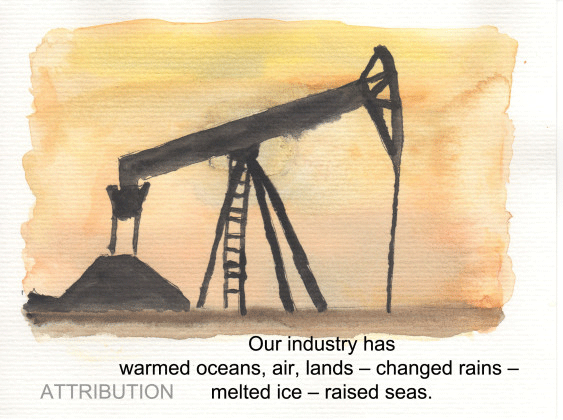
Attribution Haiku (Photo: Gregory Johnson)
CURWOOD: Now, will you read two more for us that are closely related? They are called Response and Attribution.
JOHNSON: Yes, the first one is Response.
We burn more carbon
Air warms for decades but seas
For millennia
And then Attribution:
Our industry has
warmed oceans, air, lands, changed rains
melted ice, raised seas
CURWOOD: Incredible how so few words can be so powerful. What got you going with haiku?
JOHNSON: I post almost exclusively in haiku on Facebook. I find that it helps me be in the present. It tends to link my posts a little more closely to nature and what’s going on around me. And it also limits the number of posts, which my friends probably like.
CURWOOD: Now, it seems that all of your poems are accompanied by a water color painting—the last one about industry goes along with a painting of an oilrig. There’s another with a painting of windmills on a rolling hill. Will you read that please?

Future, Reprise Haiku (Photo: Gregory Johnson)
JOHNSON: Let’s see.
Fast, strong action will
Reduce future warming but
Rising seas certain
CURWOOD: So, Greg, what kind of responses have you gotten so far from this project?
JOHNSON: They’ve really been quite positive. But I have to say, actually, it took some time, on my part, to get up the courage to put this out there. This is, of course, a distillation of, as you said, work of 209 lead authors, 50 review editors, a thousand expert reviewers, so a huge amount of work went into this. But the response actually to the haikus have been remarkably positive.
CURWOOD: What kind of response have you gotten from your IPCC co-authors?
JOHNSON: They enjoy it. I did make a number of little booklets on my own dime, and have given them to friends and colleagues and authors. And it’s been a positive response from them as well.
CURWOOD: Have you run out of the booklets?
JOHNSON: Pretty much. Yes.
CURWOOD: What’s your publisher say?
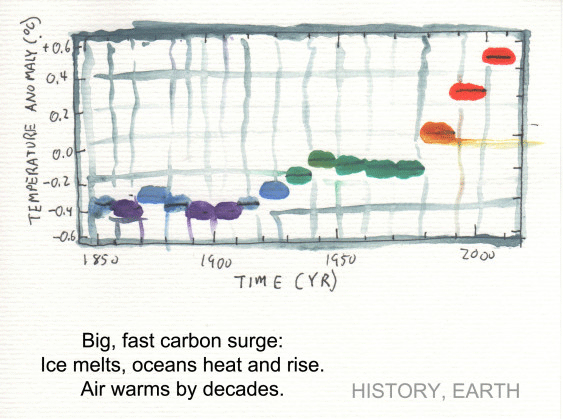
History, Earth Haiku (Photo: Gregory Johnson)
JOHNSON: I don’t have a publisher. These were are self-published. I can’t actually profit from these in any way because they’re related to my work, and that’s just one of the rules of my employer.
CURWOOD: Well, we are just about out of time, Greg, but I wonder if you will read one final haiku for us. Perhaps the one that you titled “Future”?
JOHNSON: Alright.
Forty years from now
Children will live in a world
Shaped by our choices.
CURWOOD: Greg, you have children?
JOHNSON: I have a daughter.
CURWOOD: Who’s how old?
JOHNSON: She’s 17 now.
CURWOOD: So, when she’s 57...
JOHNSON: ...the world will be a very different place, I think, and it will depend on what choices we make. We’re living in a world now that’s already shaped by our choices.
CURWOOD: Greg Johnson is a NOAA oceanographer and lead author of the Working Group I report chapter on oceans. Thanks so much for taking the time with us today.
JOHNSON: Thank you.
Related links:
- Daily Sightline
- The IPCC Summary For Policy Makers Physical Science Assessment
[MUSIC: Jeremy Pelt “Haiku” from Identity (MaxJazz 2005)]
CURWOOD: Living on Earth is produced by the World Media Foundation. Naomi Arenberg, Bobby Bascomb, Emmett Fitzgerald, Helen Palmer, Adelaide Chen, James Curwood, Lauren Hinkel, Jake Lucas, Abi Nighthill, Jennifer Marquis and Olivia Powers all help to make our show. Jeff Turton is our technical director. Alison Lirish Dean composed our themes. You can find us anytime at LOE.org, and please like us on our Facebook page: it’s PRI’s Living on Earth. And we tweet from @LivingOnEarth. I'm Steve Curwood. Thanks for listening.
ANNOUNCER 1: Funding for Living on Earth comes from the Grantham Foundation for the protection of the environment, supporting strategic communications and collaboration in solving the world’s most pressing environmental problems. The Kendeda Fund, furthering the values that contribute to a healthy planet, and Gilman Ordway for coverage of conservation and environmental change. Living on Earth is also supported by Stony Field Farm, makers of organic yogurt, smoothies and more. www.stonyfield.com.
ANNOUNCER 2: PRI, Public Radio International.
Living on Earth wants to hear from you!
Living on Earth
62 Calef Highway, Suite 212
Lee, NH 03861
Telephone: 617-287-4121
E-mail: comments@loe.org
Newsletter [Click here]
Donate to Living on Earth!
Living on Earth is an independent media program and relies entirely on contributions from listeners and institutions supporting public service. Please donate now to preserve an independent environmental voice.
NewsletterLiving on Earth offers a weekly delivery of the show's rundown to your mailbox. Sign up for our newsletter today!
 Sailors For The Sea: Be the change you want to sea.
Sailors For The Sea: Be the change you want to sea.
 The Grantham Foundation for the Protection of the Environment: Committed to protecting and improving the health of the global environment.
The Grantham Foundation for the Protection of the Environment: Committed to protecting and improving the health of the global environment.
 Contribute to Living on Earth and receive, as our gift to you, an archival print of one of Mark Seth Lender's extraordinary wildlife photographs. Follow the link to see Mark's current collection of photographs.
Contribute to Living on Earth and receive, as our gift to you, an archival print of one of Mark Seth Lender's extraordinary wildlife photographs. Follow the link to see Mark's current collection of photographs.
 Buy a signed copy of Mark Seth Lender's book Smeagull the Seagull & support Living on Earth
Buy a signed copy of Mark Seth Lender's book Smeagull the Seagull & support Living on Earth

